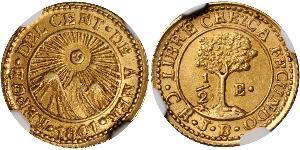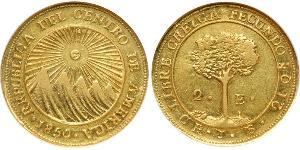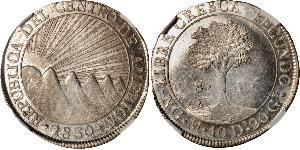| preceded by | ||||
|
||||
|
|||||||||||||||
|
|
|||||||||||||||
| succeeded by | ||||
|
| Federal Republic of Central America (1823 - 1838)from the Wikipedia | Read original article |
| Federal Republic of Central America | ||||||||||||||||||||||
| República Federal de Centroamérica | ||||||||||||||||||||||
|
||||||||||||||||||||||
|
||||||||||||||||||||||
| Anthem La Granadera "The Song of the Grenadier" |
||||||||||||||||||||||
| Capital | Guatemala City (1821-1834) San Salvador (1834-1838) |
|||||||||||||||||||||
| Languages | Spanish | |||||||||||||||||||||
| Government | Republic | |||||||||||||||||||||
| History | ||||||||||||||||||||||
| - | Independence from Spanish Empire | September 15, 1821 | ||||||||||||||||||||
| - | Independence from First Mexican Empire | July 1, 1823 | ||||||||||||||||||||
| - | Disestablished | May 31, 1838 | ||||||||||||||||||||
| Currency | Central American Republic real | |||||||||||||||||||||
|
||||||||||||||||||||||
| Today part of | ||||||||||||||||||||||
| Part of a series on |
| Central America |
|---|
 |
|
Countries
|
|
Culture
|
|
|
|
Economy
|
|
Education
|
|
|
Politics and government
|
|
Transportation
|
|
Related topics
|
The Federal Republic of Central America (Spanish: República Federal de Centroamérica), also called United Provinces of Central America in its first year of creation, was a sovereign state in Central America, which consisted of the territories of the former Captaincy General of Guatemala of New Spain. It existed from September 1821 to 1841, and was a republican democracy. It is also sometimes incorrectly referred to in English as the United States of Central America.
The republic consisted of the present-day states of Guatemala, El Salvador, Honduras, Nicaragua, and Costa Rica. (Panama was part of Bolivar's Republica de Colombia in 1821, and Belize was a British colony.) In the 1830s, an additional sixth state was added – Los Altos, with its capital in Quetzaltenango – occupying parts of what are now the western highlands of Guatemala and Chiapas state in southern Mexico.
Shortly after Central America declared independence from the Spanish Empire, it was annexed by the First Mexican Empire in 1821. When the First Mexican Empire ended, Central America again became independent and formed the Federal Republic in 1823. From 1838 to 1840 the federation descended into civil war, with Conservatives fighting against Liberals and separatists fighting to secede. Without a sustained struggle for independence to cement a sense of national identity, the various political factions were unable to overcome their ideological differences and the federation dissolved after a series of bloody conflicts.[1]
Contents
History[edit]
Independence[edit]
From the 16th century through 1821, Central America formed the Captaincy General of Guatemala within the Spanish Empire. In 1821 a congress of Central American Criollos in Guatemala City composed the Act of Independence of Central America to declare the region's independence from Spain, effective on 15 September of that year.[2] That date is still marked as independence day by most Central American nations. Independence was short-lived, for the conservative leaders in Guatemala welcomed annexation by the First Mexican Empire of Agustín de Iturbide on 5 January 1822.
The annexation was controversial, with some seeing the Mexican constitution with its abolition of slavery and establishment of free trade as an improvement over the status quo. Central American liberals objected to this, but an army from Mexico under General Vicente Filisola occupied Guatemala City and quelled dissent. When Mexico became a republic the following year, it acknowledged Central America's right to determine its own destiny. On 1 July 1823, the congress of Central America declared absolute independence from Spain, Mexico, and any other foreign nation, and a Republican system of government was established.
Dissolution of the union[edit]
In practice, the federation faced insurmountable problems, and the union slid into civil war between 1838 and 1840.[3] Its disintegration began when Nicaragua separated from the federation on November 5, 1838, followed by Honduras and Costa Rica[4] (other sources give Nicaragua's secession date as April 30).[5] Because of the chaotic nature of this period an exact date of disestablishment does not exist, but on May 31, 1838, the congress met to declare that the provinces were free to create their own independent republics.[5] In reality, this merely legally acknowledged the process of disintegration that had already begun.[6] The union effectively ended in 1840, by which time four of its five states had declared independence. The official end came only upon El Salvador's self-proclamation of the establishment of an independent republic in February 1841.
Politics[edit]
The liberal democratic project was strongly opposed by conservative factions allied with the Roman Catholic clergy and the wealthy landowners. Transportation and communication routes between the states were extremely deficient. The bulk of the population lacked any sense of commitment towards the broader federation, perhaps owing to their continued loyalty to the Roman Catholic Church in Spain.
The federal bureaucracy in Guatemala City proved ineffectual, and fears of Guatemalan domination of the union led to protests that resulted in the relocation of the capital to San Salvador in 1831. Wars soon broke out between various factions both in the federation and within individual states. The poverty and extreme political instability of the region prevented the proposed construction of an inter-oceanic canal (see Nicaragua Canal and Panama Canal), from which Central America could have obtained considerable economic benefits.
Name and emblems[edit]
Central American liberals had high hopes for the federal republic, which they believed would evolve into a modern, democratic nation, enriched by trade passing through it between the Atlantic and the Pacific oceans. These aspirations are reflected in the emblems of the federal republic: the flag shows a white band between two blue stripes, representing the land between two oceans. The coat of arms shows five mountains (one for each state) between two oceans, surmounted by a Phrygian cap, the emblem of the French Revolution.
The coat of arms on the nation's flag from 1823–1824 referred to the federation (in Spanish) as Provincias Unidas del Centro de América ("United Provinces of the Center of America"); however, its 1824 constitution, coat of arms, and flag called it República Federal de Centroamérica / Centro América ("Federal Republic of Central America").
The flag was introduced to the area by Commodore Louis-Michel Aury inspired by the Argentine flag. The term United Provinces was also used in Argentina's first title Provincias Unidas del Río de la Plata ("United Provinces of the River Plate"). Commodore Aury established the first independent republic in Old Providence Island (Isla de Providencia) in 1818, off the coast of Nicaragua.
Successor flags[edit]
Today, all five successor nations’ flags retain the old federal motif of two outer blue bands bounding an inner white stripe (Costa Rica modified its flag significantly in 1848 by darkening the blue and adding a double-wide inner red band, in honor of the French tricolor). The short-lived sixth state of Los Altos voted to be annexed by Mexico as the state of Chiapas.
 |
 |
 |
 |
 |
 |
| Guatemala | El Salvador | Honduras | Nicaragua | Costa Rica | Los Altos |
 |
 |
 |
 |
 |
 |
| Guatemala | El Salvador | Honduras | Nicaragua | Costa Rica | Chiapas |
Later Central American federal unions[edit]
Despite the failure of a lasting political union, the sense of shared history and the hope for eventual reunification persist in the nations formerly in the union. Various attempts were made to reunite Central America in the nineteenth and early twentieth centuries, but none succeeded for any length of time:
- The first attempt was in 1842 by former President Francisco Morazán, who became involved in a struggle for control over Costa Rica. After taking control over the capital, Morazán announced he would create a large army to re-create the Federal Republic as the Confederation of Central America and planned to include El Salvador, Guatemala, Honduras, and Nicaragua, but popular feeling rapidly turned against him and a sudden revolt resulted in his arrest and execution by firing squad in September 15 of that year.
- A second attempt was made in October 1852 when El Salvador, Honduras and Nicaragua created a Federation of Central America (Federación de Centro América). The union lasted less than a month.
- In 1856–1857 the region successfully established a military coalition to repel an invasion by U.S. adventurer William Walker.
- Guatemalan President General Justo Rufino Barrios attempted to reunite the nation by force of arms in the 1880s but he died in battle near the town of Chalchuapa, El Salvador.
- A third union of Honduras, Nicaragua, and El Salvador as the Greater Republic of Central America or "República Mayor de Centroamérica" lasted from 1896 to 1898.
- The latest attempt occurred between June 1921 and January 1922 when El Salvador, Guatemala, Honduras and Costa Rica formed a (second) Federation of Central America. The treaty establishing this federation was signed at San José, Costa Rica on January 19, 1921.[7] The treaty stipulated for the future creation of one state of all the four signatories, under one constitution. This second Federation was nearly moribund from the start, having only a Provisional Federal Council made up of delegates from each state.
See also[edit]
- Gran Colombia – another short-lived post-Spanish federal state
- Peru–Bolivian Confederation – another short-lived post-Spanish federal state
- Golden Circle (proposed country) – a proposed Caribbean federation
- United States of South America
- Central American Integration System
References[edit]
- ^ Foster, Lynn V. (2000). A Brief History of Central America. New York: Facts on File. pp. 134–136. ISBN 0-8160-3962-3.
- ^ "Documentos de la Union Centroamericana" (PDF). Organization of American States - Foreign Trade Information System. Retrieved 12 October 2014.
- ^ "New Physical, Political, Industrial and Commercial Map of Central America and the Antilles: With a Special Map of the Possessions of the Belgian Colonization Company of Central America, the State of Guatemala". World Digital Library. 1845. Retrieved 2013-07-04.
- ^ Minster, Christopher. "The Federal Republic of Central America (1823-1840)". Latin American History. About.com. Retrieved 2013-11-05.
- ^ a b Sandoval, Victor Hugo. "Federal Republic of Central America". Monedas de Guatemala. Retrieved 2013-11-05.
- ^ Karnes, Thomas L. (1961). The Failure of Union: Central America, 1824-1960. Durham, NC: University of North Carolina Press. p. 85.
- ^ Text in League of Nations Treaty Series, vol. 5, pp. 10-31.
External links[edit]
- Constitutions from several attempts at Central American unification (in Spanish)
- Central America- Historical Unions and Federations
- WorldStatesmen- Guatemala
- Map of the FRCA
|
|||||||||||||||||||||||||||||||||||||||||
- Former republics
- Former countries in North America
- Former federations
- States and territories established in 1823
- States and territories disestablished in 1838
- States and territories established in 1824
- 1838 disestablishments in the Federal Republic of Central America
- History of Central America
- History of Nicaragua
- History of Guatemala
- History of El Salvador
- History of Honduras
- History of Costa Rica
- Federal Republic of Central America
- Former countries in Central America
- 1824 establishments in the Federal Republic of Central America












